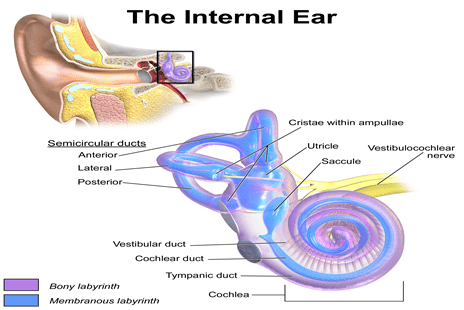Benign – not dangerous or life threatening
Paroxysmal – Rapid onset, brief episodes
Positional – triggered by head positions
Vertigo – abnormal sensation of movement
BPPV is the most common vestibular disorder that causes vertigo. Symptoms such as nausea, vomiting and light headedness may also be present. Episodes of vertigo typically last less than a minute. It is triggered by changes in head movements such as rolling over or getting in or out of bed, bending over, looking up or down, standing up suddenly or climbing up and down ladders.
BPPV occurs when calcium carbonate crystals (otoconia) break free from the utricle (sensory organ) in the inner ear and fall into one of the semicircular canals. Head movement moves fluid around in the semicircular canals in the inner ear. This excites receptors, sending messages to the brain about the position of your head. The brain then activates muscles around the eyes and in body in response to head movement, resulting in clear vision and postural stability.
When the calcium carbonate crystals accumulate in the canals, it interferes with fluid movement, causing the receptors in the semicircular canals to become over excited. The signal to the brain is stronger and does not match with what the ear is sensing, the eyes are seeing or what the muscles and joints are doing. The brain thinks the head is spinning, resulting in vertigo.
What causes BPPV?
Most BPPV is idiopathic but can be caused by head trauma (up to 20% of cases), migraine, degeneration or damage caused by an inner ear disorder such as viral labyrinthitis, vestibular neuritis or Meniere’s disease, reduced blood flow to name a few.
Unfortunately, BPPV does have a high recurrence rate. Up to 50% of people will experience symptoms again within five years, particularly for those caused by head trauma.
How is it diagnosed and treated?
BPPV can successfully be assessed and treated with various tests and manoeuvres by a trained health professional. When the brain thinks the head is spinning it mistakenly causes rapid eye movement in a specific pattern to occur called “nystagmus”. Nystagmus presents differently depending on which ear is affected, the canal the crystals has fallen into, if it is free floating or stuck on a receptor. Various tests enable your health professional to take you through the correct manoeuvres to dislodge or/and use gravity to guide the crystals back into the correct chamber. Other vestibular physiotherapy includes the use of exercises to help desensitise the vestibular system, improve eye-head coordination, balance and gait retraining.
With care for all the BPPV sufferers out there,

